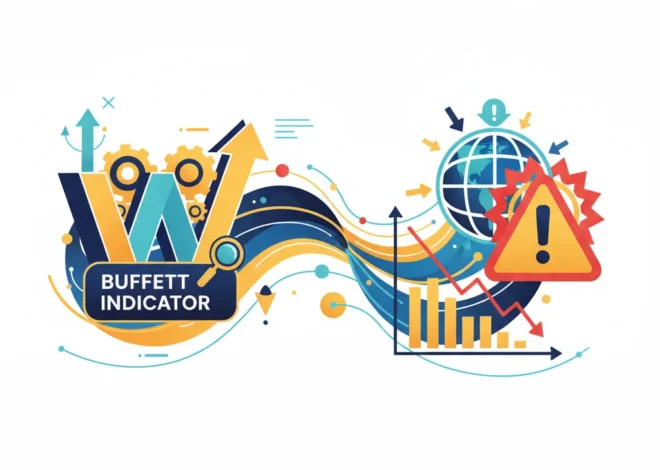
The Investor’s Paradox: What a “Thrifty Gene” Reveals About Surviving a Bull Market
The Scarcity Mindset in a World of Abundance
In the world of finance and investing, we are conditioned to prepare for the worst. We build portfolios designed to weather economic downturns, diversify assets to mitigate risk, and hold cash reserves for the proverbial rainy day. This is the financial equivalent of storing food for the winter—a survival strategy honed over centuries of economic famines and feasts. It’s a prudent, time-tested approach. But what if the environment changes so drastically that our survival instincts become our biggest liability?
This is the central question posed by a fascinating biological concept that has profound implications for the modern economy: the ‘thrifty gene’ hypothesis. Proposed in 1962, this theory suggests that some human populations evolved genes that are exceptionally good at storing fat from every calorie consumed. In an ancestral environment of unpredictable food supply, this was a life-saving advantage. Those with the ‘thrifty gene’ were more likely to survive famines and pass on their efficient energy-storing DNA. In the language of the stock market, they were perfectly hedged against scarcity.
Today, however, in a world of caloric abundance, this genetic gift has turned into a curse. It’s now strongly linked to high rates of obesity, type 2 diabetes, and heart disease. The very mechanism designed for survival in one economic reality becomes a pathway to chronic illness in another. This biological paradox offers a powerful lens through which we can analyze the challenges facing our current financial systems, investment strategies, and corporate governance.
A surprising new finding, however, has added a fresh twist to this decades-old theory, forcing scientists—and by extension, us—to rethink the fundamental relationship between risk factors and actual outcomes. A study of the Tsimane people in the Bolivian Amazon has uncovered a genetic variant that, while promoting obesity, simultaneously appears to protect them from its worst consequences, like heart disease. This discovery, as reported by the Financial Times, is not just a medical curiosity; it’s a blueprint for understanding nuance in a world that often relies on blunt instruments to measure health, whether biological or financial.
When Corporate Strategy Mirrors Genetic Code
Let’s translate this biological concept into the language of business and economics. A company with a ‘thrifty gene’ is one that obsesses over cost-cutting, hoards cash, and avoids debt at all costs. It’s the archetypal blue-chip industrial giant of the 20th century. In a stable, predictable economy with high capital costs, this was the winning formula. This corporate “fat”—retained earnings and low leverage—allowed it to survive recessions and market shocks with ease.
But in the 21st-century economy, characterized by rapid technological disruption, low interest rates, and the paramount importance of innovation, this ‘thrifty’ model often fails. The corporate environment has become one of abundance—an abundance of cheap capital, data, and market opportunities. In this new reality:
- Cash Hoarding Becomes Inefficiency: Large cash reserves that once signaled stability now often point to a lack of imagination and an inability to invest in future growth. Activist investors target these companies, arguing the capital should be returned to shareholders or deployed in higher-growth ventures.
- Debt Aversion Becomes a Hindrance: An aversion to leverage means missing out on opportunities to finance growth, M&A, and R&D at historically low costs. The financial technology (fintech) revolution has made capital more accessible than ever, rewarding those who can strategically deploy it.
- Operational “Efficiency” Stifles Innovation: An excessive focus on optimizing existing processes (the corporate equivalent of storing calories) leaves little room for the kind of experimentation and risk-taking that leads to breakthrough products and services.
The ‘thrifty’ corporation, like the individual with the ‘thrifty gene’, becomes metabolically unhealthy in this new environment. It may look stable on a traditional balance sheet, but it’s slow, uncompetitive, and at high risk of being disrupted by leaner, more agile startups that are genetically programmed for an environment of abundance. Echoes of 2008? Why Wall Street's Titans Are Sounding the Alarm on a New Debt Crisis
The Tsimane Revelation: Decoupling Risk from Catastrophe
The recent study on the Tsimane people completely upends the traditional ‘thrifty gene’ narrative. Researchers identified a specific gene variant, CIDEA, which is linked to a higher BMI and body fat percentage. According to the old model, this should correlate with poor cardiovascular health. Yet, the Tsimane have famously healthy hearts. The study found that this same gene variant was associated with lower cholesterol and blood pressure, effectively neutralizing the danger typically associated with obesity. According to the research, the gene variant seems to change how fat is stored and how the body’s inflammatory response works.
This is a paradigm shift. It suggests that the problem isn’t the fat storage itself, but the *consequences* of that storage, such as chronic inflammation. By finding a biological mechanism that decouples the two, science opens a new frontier for treatment.
Let’s map this groundbreaking discovery onto our economic and financial models. For decades, economists and market analysts have used certain metrics as reliable indicators of impending doom.
The table below illustrates the shift in thinking this discovery prompts, both in medicine and finance:
| Domain | Old Paradigm (Simple Correlation) | New Paradigm (Nuanced Causation) |
|---|---|---|
| Health & Medicine | High BMI (obesity) directly causes heart disease. Strategy: Lose weight at all costs. | A specific genetic expression of fat storage, combined with inflammation, causes heart disease. Strategy: Target inflammation, not just weight. |
| Corporate Finance | High debt-to-equity ratio directly causes high bankruptcy risk. Strategy: Avoid debt. | High debt combined with low cash flow and poor asset quality causes bankruptcy. Strategy: Optimize capital structure for growth, ensuring cash flow can service the debt. |
| Stock Market Analysis | A high P/E ratio means a stock is overvalued and risky. Strategy: Buy low P/E “value” stocks. | A high P/E ratio combined with slowing growth and low moat is risky. A high P/E driven by exponential growth in a large addressable market may be undervalued. |
Just as the Tsimane finding suggests we should target inflammation rather than just weight, this new paradigm pushes investors and business leaders to look past surface-level metrics. A fintech company might burn through cash at an alarming rate (high “obesity”), but if it’s capturing market share and has a clear path to profitability, it may be far healthier than a legacy bank with a “healthy” balance sheet but a declining customer base.
Anatomy of a Meltdown: How a Rogue Trader Cost Nestlé a Fortune
Investment Implications for a Post-Thrifty World
This shift from simple correlation to nuanced causation has tangible consequences for anyone involved in finance, investing, or business leadership.
1. The Future of Healthcare and Biotech Investing
The most direct impact is on the healthcare sector. The global market for weight-loss drugs is already exploding, but the Tsimane research points to the next frontier. Companies that can develop therapies to mimic the protective effects of the CIDEA variant—tackling inflammation and metabolic dysfunction without necessarily focusing on weight loss—could unlock immense value. This represents a multi-hundred-billion dollar opportunity. Investors should look beyond the current generation of GLP-1 drugs and identify biotechs working on novel pathways related to metabolic health and inflammation. The potential for such innovation is a powerful signal for long-term allocation in the biotech and pharma sectors.
2. A Revolution in Risk Modeling and Financial Technology
The ‘thrifty gene’ mismatch is a perfect analogy for the failure of legacy risk models. Traditional banking and investment analysis relied on a limited set of data points (like credit scores or financial statements) to assess risk. Today, fintech and AI are enabling a more Tsimane-like analysis. They can process vast, alternative datasets—from satellite imagery of retail parking lots to supply chain data secured on a blockchain—to build a much more sophisticated picture of a company’s health. This allows for the identification of companies that look “obese” on paper (high spending, low profits) but are incredibly healthy in terms of customer acquisition, engagement, and market positioning. Investing in the financial technology that enables this deeper analysis is a core strategy for the next decade.
3. Redefining Economic Health and Productivity
On a macroeconomic scale, this concept challenges how we measure the health of an economy. For years, low national debt and a trade surplus were seen as unambiguous signs of a ‘healthy’ economy. However, an economy that doesn’t invest in infrastructure, education, and technology—choosing to be ‘thrifty’—will ultimately suffer from low productivity and stagnating growth. The Tsimane discovery is a metaphor for smart investment: it’s not about avoiding “fat” (spending, debt), but about ensuring that fat is healthy and productive, driving growth without creating systemic “inflammation” (asset bubbles, runaway inflation).
Tesla's Trillion-Dollar Tightrope: Can a Two-Model Empire Withstand the Global EV Onslaught?
Conclusion: From Survival to Thriving
The journey of the ‘thrifty gene’ hypothesis—from a simple explanation for obesity to a complex story of genetic nuance—is a masterclass in how our understanding of complex systems must evolve. It teaches us that strategies optimized for a past environment can become fatal in the present. It proves that the metrics we use to measure risk are often crude proxies for a much more complicated reality.
For investors, executives, and financial professionals, the lesson is clear. We must resist the comfort of our own ‘thrifty’ instincts—the reliance on outdated models and simplistic indicators. The future of successful investing and trading will not be about avoiding risk, but about understanding it with greater precision. It will be about distinguishing between the corporate equivalent of benign obesity and the kind that leads to a catastrophic heart attack. In the modern economy, as in modern medicine, the key to not just surviving but thriving lies in looking past the symptoms to understand the true, underlying drivers of health and disease.


